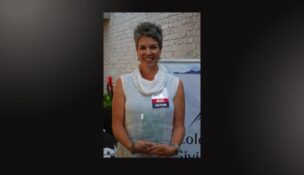Building the brand that is Jennifer Kupcho
Westminster’s golf phenom settles into the business of life on the LPGA Tour
Susan Fornoff //April 9, 2020//


Building the brand that is Jennifer Kupcho
Westminster’s golf phenom settles into the business of life on the LPGA Tour
Susan Fornoff //April 9, 2020//

Photo by E J Carr.
Wake Forest grads were already doing pretty well, collecting a reported average starting salary of almost $57,000 right out of college. Then in May 2019, Jennifer Kupcho finished her degree and went to work on the Ladies Professional Golf Association’s world tour: six months of work, $525,432 in earnings, nearly 10 times better than the average Demon Deacon.
She bought a car. Not a fancy one.
“I got a silver Honda CRV,” Kupcho says over the phone from her winter home in Scottsdale, Arizona. “That’s been my dream car for so long, and it’s a safe car, so I decided, ‘I’m going to do it.’”
What did she do with the rest? Any stocks she likes? You’d have to ask the accountant, her dad, Mike.
“I don’t really know,” she says, giggling. “I’m still only 22 and learning.”
The last year has been an educational whirlwind for Westminster’s Kupcho, the star pupil of Ranch Country Club director of instruction Ed Oldham and the best-known name in Colorado golf since Hale Irwin. She’d won numerous titles and NCAA championships before her life changed in one afternoon. On April 6, she won the inaugural Augusta National Women’s Amateur with a dramatic and moving display of birdies, eagles and sportsmanship in front of an enthralled crowd and national television audience. She became the face of American hope in a sport increasingly dominated by Asians, yet she delayed her professional debut until after she’d finished her college season and degree.
Finally, at the U.S. Women’s Open on Memorial Day weekend, she teed off (with Mike on the bag) for a share of the purse, making the cut and finishing tied for 62nd, good for $11,303. After two months that included three missed cuts, a fifth, and three other checks, Kupcho hit it big at the Evian Championship, finishing second to guarantee her eligibility for 2020 and earning $290,778.
By the season’s end, she had money stashed away (somewhere), a full-time caddie on the bag (Kyle Callan, ex of Paula Creamer) and professional representation (Mary Lyle Townsend of Wasserman) for her new “brand.”
“They constantly remind me, ‘You represent yourself, this is your brand, what do you want it to be?’ “ Kupcho says. “It’s definitely a different way of thinking. You don’t realize how much of a job this really is until you get out here. Growing up, it’s, ‘Oh, I just want to go play golf for a living.’ That’s not all it is. There’s a lot of other stuff.”
Much of that “other stuff” has, so far, benefitted Kupcho beyond the entry level of the typical LPGA rookie. For starters, the typical LPGA rookie uses local caddies and isn’t sought after by agents. Says Townsend, who cultivated a relationship through Wake Forest and Kupcho’s family for months before signing the player after the Evian, “The win at Augusta had a lot of different touch points, within golf, outside golf, for women, for college golfers. She can sit next to a lot of the top men’s players and be the only one there that has a title at Augusta. That’s pretty special.” In other words, lucrative: Kupcho’s “partners” (the latest jargon for sponsors who pay players to use their brands) so far include Ping for equipment, Titleist for balls and Footjoy for shoes and gloves.
“We have another corporate partner that will be announced soon,” promised Townsend, who also was working on an apparel affiliation.
Kupcho’s package won’t amount to anything near the rookie deals of charismatic Michelle Wie, who debuted in 2005 as a 15-year-old with Nike and Sony contracts said to be worth $5 million a year. And she won’t be covered head to toe in logos, like many of the Asian players who join the LPGA after already having won several tournaments in Korea and Japan. But it’s safe to say she can cover the global expenses of an increasingly high-mileage circuit.
“Every week you’re paying for flights, you’re paying for a rental car, paying for food,” Kupcho says. “You’re paying for a caddie, which is big. It doesn’t cross your mind, and it’s a huge expense.”
Most caddies these days are paid a flat fee plus a percentage of their players’ earnings. All told, Townsend, who also represents Morgan Pressel and a few PGA Tour men, estimates average annual expenses at between $40,000 and $80,000.
“That’s a wide range, I know,” Townsend says. “Jennifer’s very good about staying with friends or family friends, and she’s very smart about her finances. I think the car was the extent of her splurges.”
Indeed, Kupcho laughs at the thought of a PGA Tour-style entourage including trainers and mental coaches. She counts among her “team” only Townsend, Callan, Oldham and her short-game coach, Wake Forest associate head coach Ryan Potter, supplementing them with LPGA staff physical therapists and trainers. She also takes advantage of the LPGA’s host family programs. “I don’t really stay in hotels,” she says. “You’re obviously saving money, but, there’s the whole social thing: At a hotel, you’re going to be stuck in a room. I’d rather be staying in a house with a family and be able to be social and live in a house environment.”
Signing on with Wasserman has relieved her of the logistics — the travel, the schedule, the media – that at first seemed overwhelming. “In college,” Kupcho says, “your coaches organize everything – travel, food, where you’re eating, all those simple things you don’t really think about. And then you get out on tour and you have to figure out your travel, your time management, taking care of your body, listening to what your body needs as far as rest and what your game needs as far as practice. It’s trial and error.
“With my agent, there are definitely things you’re scared to ask for, even, ‘Hey, how is this flight looking?’ We talk pretty much every day, and sometimes I wonder, ‘Oh, am I annoying you too much, sending you five questions in a row and expecting answers for all of them?’ But they’re there for you, and it’s getting to the point where I might as well ask all my questions because they know all the answers.”
Not that she’s completely passive. After so many six-day work weeks (practice round on Tuesday, pro-am Wednesday, then four days of golf), Kupcho was adamant about not playing more than five tournaments in a row her second year. “Last year I played six in a row, and that was absolutely awful, and even during the fifth one I was kind of dead,” she says. “This year I have a stretch of five, but only because two of them are only three-day events instead of the normal four.”
Playing in only 19 tournaments last year, she made more money than all but 38 players; this year, she’ll play at least 26 tournaments in hopes of cashing as many checks as possible. And one victory alone could surpass her 2019 winnings, which weren’t bad for one’s first year after college.

























